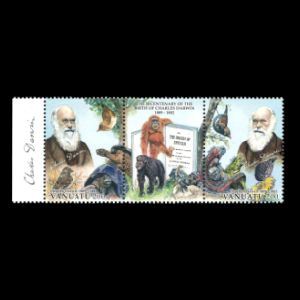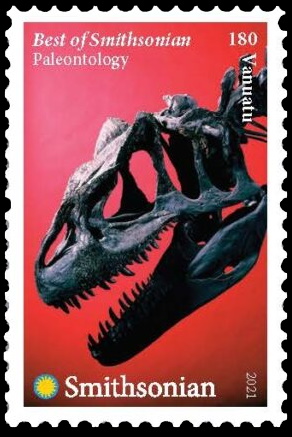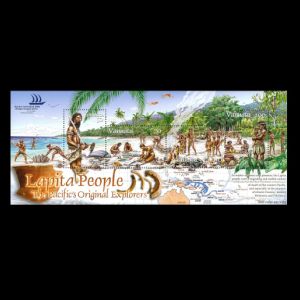the place where Paleontology and Paleoanthropology meets Philately
Vanuatu
Charles Darwin on stamps of Vanuatu
| << previous country | back to index | next country >> |
Contents:
- Country overview
- Philately of Vanuatu
- Official stamps of Vanuatu related to Paleontology and Paleoanthropology
- Some other stamps of Vanuatu to consider
- References
- Acknowledgements
Vanuatu, officially the Republic of Vanuatu, is a Pacific island nation located in the South Pacific Ocean. The archipelago, which is of volcanic origin, is some 1,750 kilometres east of northern Australia, 540 kilometres northeast of New Caledonia, east of New Guinea, southeast of the Solomon Islands, and west of Fiji.
Vanuatu was first inhabited by Melanesian people. The first Europeans to visit the islands were a Spanish expedition led by Portuguese navigator Fernandes de Queirós, who arrived on the largest island in 1606.
As the Portuguese and Spanish monarchies had been unified under the king of Spain in 1580, Queirós claimed the archipelago for Spain, as part of the colonial Spanish East Indies, and named it La Austrialia del Espíritu Santo. In the 1880s, France and the United Kingdom claimed parts of the archipelago, and in 1906 they agreed on a framework for jointly managing the archipelago as the New Hebrides through an Anglo–French Condominium.
An independence movement arose in the 1970s, and the Republic of Vanuatu was founded in 1980. [R1]
Between 1906 and 1980, the islands were an Anglo-French Condominium. One of the outcomes of this arrangement was that both countries issued their own postage stamps for the islands, although towards the end of the Condominium, there were joint issues with the initials ER (Elizabeth Regina) for the UK, and RF (République Française) for France.
Modern stamps have been issued under the name Vanuatu.
From 1887 to 1899, the people of the New Hebrides received their international mail from Australasian New Hebrides Company steamers every three weeks.
Almost all of the country’s 83 islands were serviced by these steamer ships, proving to be a great, but unprofitable service for the times.
The Australian Post Office for a time was contracted to bring in the mail, but it wasn’t really until 1910 when Port Vila’s new post office was open to the public that the country began to have its own postal identity.
The Condominium administration ran the post office in typical New Hebridean fashion – selling stamps in both francs and pence, however the service quickly became a good revenue earner for the administration. [R2]
Official stamps of Vanuatu related to Paleontology: Dinosaurs, Charles Darwin
| 23.09.2009 "Bicentenary of the birth of Charles Darwin" | 25.05.2021 "Best of Smithsonian" [1] | |
 |
 |
|
Notes:

[1] PHILATELIC COLLECTOR INC. who print stamps for several small countries, including Vanuatu, issued the "Best of Smithsonian" stamps.
Fossil skull of Tyrannosaurus rex was depicted on one of the stamps of Vanuatau.
Fossils of Tyrannosaurus rex were discovered in North America only and have nothing to do with Vanuatu
Other stamps to consider
| 02.03.2005 "The Pacific's original explorers: Lapita people" | ||
 |
|
|
Notes:
[O1] As master seafarers and pioneers, the Lapita people were a migrating and mobile culture. They are celebrated as the first Neolithic inhabitants of much of the western Pacific and especially pioneers of remote Oceania – eastern Melanesia and Polynesia.
The Lapita people, named after their finely decorated pottery, have been traced from Eastern Indonesia and the Philippines where they had occupied the islands for at least 40,000 years.
It is estimated that the Lapita people arrived in Vanuatu over 3,000 years ago directly from the Solomon Islands.
Design of these stamps are very similar to stamps of Pitcairn islands 2006 and 2007.

References:
- [R1] Vanuatu: Wikipedia, FlagCounter
- [R2] Postal History and Philately of Vanuatu:
Wikipedia.
Links to official website of the Post Authority, stamp catalog and a list of new stamps of Vanuatu are here
Acknowledgements:
Many thanks to Dr. Peter Voice from Department of Geological and Environmental Sciences, Western Michigan University, for the draft page review and his very valuable comments.
| << previous country | back to index | next country >> |